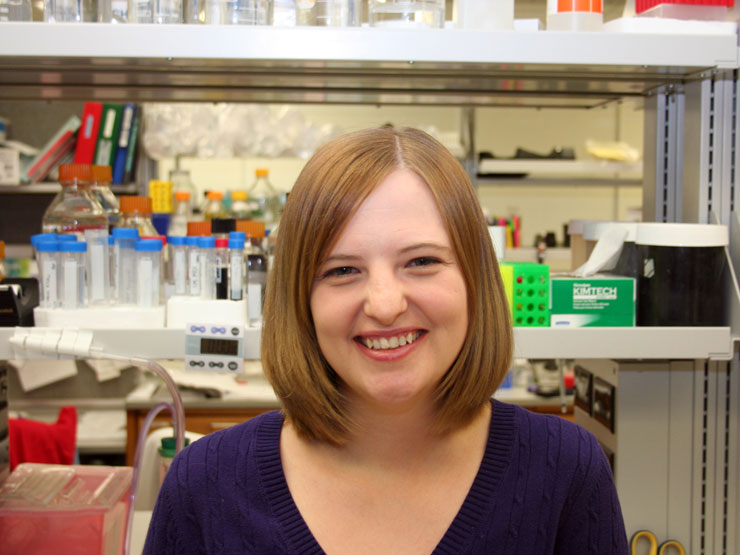
DNA methyltransferase 1 (Dnmt1) is a protein that plays an essential role in cellular transitions to malignancy. Dnmt1 is overexpressed in many cancers, where it silences genes needed to maintain normal cellular functions.
Rebecca Fagan, a postdoctoral research fellow in biochemistry at the University of Iowa, is seeking to identify chemicals that inhibit the activity of Dnmt1 and to determine what happens to cells when this enzyme is suppressed. Fagan, who earned her Ph.D. in biological chemistry at the University of Michigan, began screening a 50,000-compound library of diverse chemicals—housed at the UI—last month in an attempt to discover ones that inhibit Dnmt1.
“One of the nice things about having Dnmt1 as a target is that it sits in a position, where if you can inhibit it, you have the potential to turn on or re-express a multitude of tumor-suppressor genes that can have positive effects,” Fagan says. “We are gaining an understanding about how the enzyme works and how we can stop it from working. This research is sitting at a nice intersection between basic science and something that has the potential to be very translational.”
Fagan has worked in Charles Brenner’s laboratory at the UI for the last year. Brenner is the head of the Department of Biochemistry and Fagan’s mentor. Fagan, a native of Newton, Ill., was awarded a three-year American Cancer Society Postdoctoral Fellowship, which she is using to characterize and identify inhibitors of Dnmt1.
“Becky is an ideal postdoc for my lab, because she has a very strong enzymology background, so we have a common vocabulary,” Brenner says. “She can work quite independently. At the same time, I don’t want her to work in a vacuum. I like her to interact with other people in the laboratory, which she does, and I like to talk with her every day about research developments and challenges.”
Having a position in Brenner’s lab has allowed Fagan to continue working on her passion—enzymes. Fagan is motivated to gain an understanding of the minute details of how Dnmt1 works in the context of its cellular and organismal climate.
Identification of tumor-specific genetic and epigenetic changes recently has been made clear. Brenner says, “In mouse models, the development of both environmentally-induced cancers as well as certain types of hereditary cancer syndromes depends on overexpression of Dnmt1. This appears to be true in human cancers as well.”
Enter Fagan and her research.
“If you can isolate a protein and truly understand it in a purified and reconstituted system, you can gain invaluable information to better understand pathways and disease,” Fagan said. “I’m a firm believer that you need this base knowledge before you can understand it in the context of a very complicated [animal] system.”
Fagan indicated that her research could lead to new drug discoveries and therapeutics to treat a variety of cancers.
“There are compounds in the clinic now, which result in degradation of Dnmt1, that are being used for myelodysplastic syndromes (formerly known as pre-leukemia),” Brenner said. “But these compounds are limited by toxicity and are not particularly specific for the target that we’re working on.” Thus a goal of this research would be to identify compounds with less toxicity and better target specificity for Dnmt1.